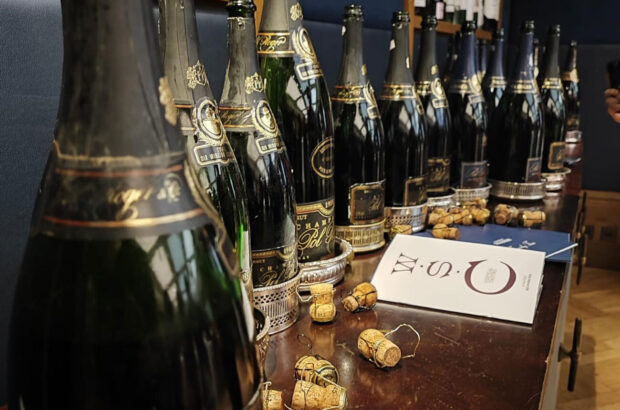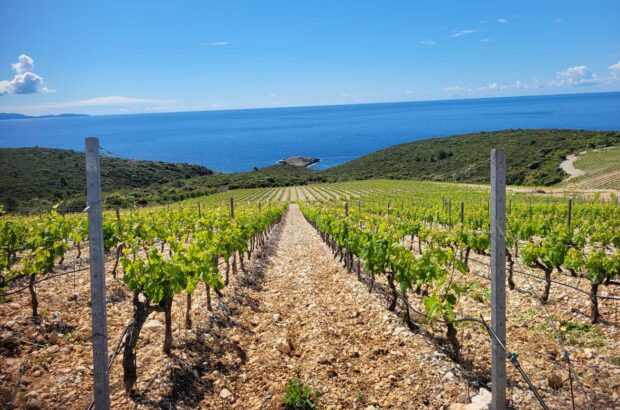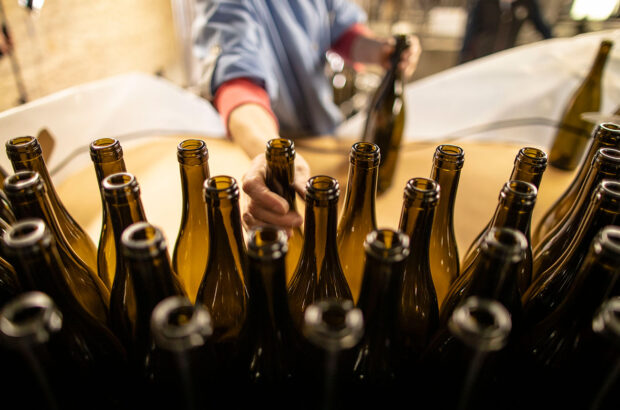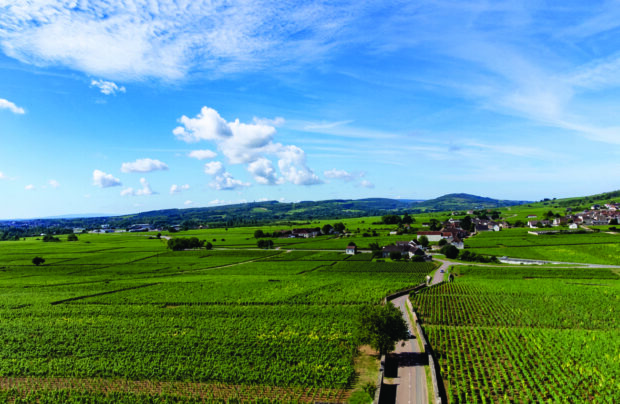- Undoubted potential but elusive fame.
- The heyday years.
- Refinement of the wine.
- A solid core of good producers.
Is Fronsac still the best kept secret in Bordeaux? Hugh Johnson, in his October 1998 column for Decanter, recalled the rosy future he had predicted for this Right Bank wine 30 years ago. Other experts have tipped Fronsac for success, also apparently to no avail. The potential undoubtedly exists, but somehow that final step up on to the world stage has remained as elusive as the Holy Grail. Or so it seemed until recently. Redoubled efforts in quality, good vintages, new investment and better distribution and communications have given renewed momentum to the region, adding a note of optimism for the years to come.
A tumble of hills and dales interspersed with tiny wooded copses, Fronsac has its own particular character and identity. Located just to the west of the town of Libourne, the region forms a triangle bounded to the east by the river Isle and to the south by the Dordogne. Two appellations co-exist, Fronsac with 825 hectares (ha) under production, and to the south the tiny 305ha enclave of Canon-Fronsac. Only the higher ground with a bedrock of limestone-clay-sandstone, known geologically as molasse du Fronsadais, is delimited for these appellations, the flat alluvial terraces of the river plains are reserved for the production of generic Bordeaux.
The frost-protecting altitude of Fronsac is an important feature, but gradients and exposures vary considerably with the twists and turns of the terrain. Terraced vineyards have even been created in a few locations. Soils, as well, provide a complex variable of limestone, clay and sand. In certain ways there is a resemblance to Saint-Emilion’s plateaux, côtes and pieds de côte, particularly as Merlot is the predominant grape variety (65–70 per cent) with Cabernet Franc, Cabernet Sauvignon and Malbec playing a supporting role. The production of wine in Fronsac can be traced back to the 13th century, but the heydays for the region were the 18th and early 19th centuries. Fronsac then sold at a higher premium than Saint-Emilion, particularly wines from the south-facing Côte Canon. In 1783 the entire crop of Château Canon was reserved for the court of the Dauphin in Versailles. But post-phylloxera decline set in and as the hillside sites were abandoned the fertile river plain was brought into production instead, and quantity superseded quality as the new maxim. Fronsac disappeared into obscurity and was not helped by the Libournais négociants who, needing good blending material, continued to hold prices down and failed to promote the region.
Two events in the 1950s helped rekindle the fire. Fronsac weathered the 1956 frost better than the other Libournais appellations, and then in a bid for commercial survival a number of producers started bottling and selling their own wines. Funds, however, remained limited and technically and qualitatively Fronsac continued to be outstripped by Pomerol and Saint-Emilion through the 1960s and 1970s. It needed the advent of new blood in the 1980s to relaunch Fronsac in a serious way. Etablissement Jean-Pierre Moueix took an interest in the region, purchasing châteaux Canon de Brem, Canon-Moueix and La Dauphine. Oenologist Michel Rolland acquired Château Fontenil, Americans Colin Ferenbach and Peter Sachs invested in Château La Vieille Cure and at a number of estates a new generation arrived at the helm.
A modern style of Fronsac evolved at these and other properties. The introduction of lower yields, greater selection, new oak barrels and better winemaking equipment combined with improved technical expertise helped refine the wines. Well coloured and naturally vigorous and firm, these have been given an extra edge of fruit and class, and the aggressive tannic edge that led to Fronsac being labelled ‘rustic’ removed. Variations of course exist according to the method of winemaking, blend of grape varieties and terroir, but this has been the trend into the 1990s. In particular there has been a marked progression in quality since 1993 with the additional assistance of a seam of good vintages from 1994 onwards. The distinction between Fronsac and Canon-Fronsac, confusing at the best of times and based principally on historical precedent, has also been pushed to one side. The contrast now is between good and indifferent winemaking.
As the 20th century draws to a close, what then are the signs that further advance is possible in Fronsac? Firstly, a solid core of good producers now exists. These account for 40–50 per cent of the vineyard area and include the early pioneers, new investors and the cooperative at Lugon. The latter obviously has a different structure from a single domaine, but a quality orientated approach has been implemented. This includes viticultural specialists on the ground to advise members, decision making on the date of harvest, selection and vinification of individual parcels and an increase in the use of new oak barrels. Amongst the early pioneers Jean-Claude Gaudrie of Château Villars introduced new oak barrels for ageing back in 1978. He has since handed over the winemaking to his son Thierry, a qualifled oenologist, but his campaign for higher standards continues. After a spell with a machine harvester the domaine returned to hand harvesting in 1991. The 42 parcels of vines at the 30ha estate are selectively harvested and where possible vinified separately. Vinification has been modified to avoid over-extraction and a percentage of the wine now run off warm into new oak barrels where the malolactic fermentation takes place; ‘I’m looking to produce wines with both elegance and power,’ says Thierry Gaudrie.
Jean-Noël Hervé returned to the family property, Château Moulin Haut-Laroque, in 1977 and has since remained one of the prime movers in the appellation. Avoiding the ‘rustic’ label has been one of his main considerations. ‘Thanks to the texture of the soils and the grape varieties, we produce naturally tannic wines. The secret, though, is to avoid harsh tannins and that vegetal edge, and this we do by leaf plucking to improve ripeness, hand harvesting, selection and destemming the grapes,’ he says. A technique he terms macro-bullage has also been introduced to add more flesh to the wines but avoid heavy extraction. A hollow metal tube is inserted into the grape cap during fermentation and either compressed air or nitrogen introduced to churn up the grape skins. This technique has also been adopted at a number of other properties including châteaux Barrabaque, Villars and La Vieille Cure, where Jean-Noël Hervé has been employed as general manager since 1994.
Variety in an appellation also creates interest and Fronsac has its fair supply of individualists. Paul Barre was the regisseur at Châteaux La Dauphine and Canon de Brem before they were acquired by J-P Moueix and now owns and manages Châteaux La Fleur Cailleau and La Grave. Both have been farmed biodynamically since 1990. ‘In simple terms, biodynamics is understanding and implementing what the peasant farmers did intuitively years ago,’ he says. Following this argument he has started replanting the vineyards with intermixed grape varieties, Merlot, Cabernet Franc and Malbec, and even some fruit trees. The winemaking, however, is more sophisticated and there are experiments presently underway into malolactic fermentation in barrel and the ageing of wines on lees without racking, but with the injection of doses of oxygen.
Michel Ponty, owner of Châteaux Grand Renouil and du Pavillon, is another independent spirit. The vineyards of both his domaines are ploughed in a traditional manner and much of the vineyard work, including the harvest, done by hand. Château Grand Renouil is produced uniquely from Merlot grown on well exposed clay-limestone slopes in the commune of Saint- Michel de Fronsac. It is one of the most elegantly textured wines in the region. ‘I don’t like big, oaky, show-winning wines and instead prefer the emphasis on complexity and finesse,’ says Michel Ponty. Yields turn around 35–40 hl/ha and the grapes are harvested and vinified parcel by parcel. Vinification takes place in temperature controlled cement tanks and the wines are then aged in oak barrels of which 20 per cent are renewed yearly. Michel Ponty also produces the only white wine in Fronsac. The Blanc de Grand Renouil is made from barrel fermented Sauvignon and Sémillon.
Originality at Château Cassagne Haut-Canon is provided by the variety of parcels of land and the high percentage of Cabernet used in the blend. The Cabernet Sauvignon is grown on poor, stoney soils that surround a grove of truffle oaks. Hence the cuvée La Truffière, a wine that represents 50 per cent of the production and which is made from 60 per cent Merlot and 20 per cent each Cabernet Franc and Cabernet Sauvignon. ‘I like the soft, round character of Merlot but feel that the Cabernet gives added length and persistence,’ explains owner Jean-Jacques Dubois. The continuing interest in the region shown by new investors has been another encouraging factor. In 1995 a number of important properties changed hands with a consequent improvement in quality. Chateau de la Rivière, the largest estate in Fronsac with over 50ha of vineyard and an imposing château, was purchased by négociant Jean Leprince. J-P Moueix acquired Château Bodet, now renamed Château Croix-Canon and châteaux Puy Guilhem and Les Trois Croix also found new owners.
The change of ownership at Château Les Trois Croix could have the most impact for the appellation. The new owner is Patrick Léon, the technical director for the Mouton-Rothschild estates, and his arrival in Fronsac has already caused a tiny stir in Bordeaux and among the trade. ‘Fronsac is an appellation in Bordeaux that has been rather overlooked but which has enormous potential for evolution. It has a unique terroir that still needs developing, which I personally find a challenge,’ he says.
The 14ha estate is managed by Léon’s son Bertrand and is being steadily overhauled. The vineyard, which includes a 10ha block of old vines, is being returned to traditional cultivation (ploughing etc), yields have been reduced and the grapes are now harvested by hand. A system for temperature control has been introduced into the cellars and the percentage of new oak barrels increased to one-third yearly. The wine is produced from 80 per cent Merlot and 20 per cent Cabernet Franc and is improving fast. Quality is one important aspect, but the success of a wine these days also hangs on good distribution and communications. The Bordeaux négociants, having ignored Fronsac for many years, have recently taken an interest in the region and a number of estates now sell their wines through the Bordeaux market. ‘There has been a growing interest in Fronsac over the last couple of years, particularly as the wines sell on the local market at between FF35 and FF40 (£3.50– 4.00), a price range for which there is a signifcant demand,’ notes Emmanuel Marley of Bordeaux-based wine brokers Balaresque. The majority of producers have their own chains of distribution but the involvement of the négociants can only help.
Getting Fronsac recognised has been another problem. Unlike the Saint-Emilion satellites and Lalande-de-Pomerol, the name does not present a lever for marketing. Fronsac is reliant on its individual crus for a reputation. This at least was the conclusion that a number of producers came to in 1988 when they formed the association ‘Expression de Fronsac’. ‘Qualitatively we all had the same ambition but decided we would make more impact as a combined force,’ says Jean-Jacques Dubois of Château Cassagne Haut-Canon. The cross-appellation membership, which includes a number of Fronsac’s high profile châteaux, makes joint presentations to the Bordeaux trade and is involved in promotional activities. In January 1999 the 10 existing estates will be joined by Châteaux Les Trois Croix, La Rivière, Renard Mondésir and Tour du Moulin, taking the vineyard area represented by the group to 20 per cent of the vineyard area of the region. The signs for Fronsac at the moment are positive. Better quality, greater presence on the market and with prices of Saint-Emilion and Pomerol climbing real value for money. This time round the cat may finally be let out of the bag.











